Abstract
This study investigates the Holocene evolution of the Laraquete-Carampangue strandplain on the tectonically active coast of south-central Chile using ground penetrating radar and light detection and ranging data. The Laraquete-Carampangue strandplain, on the tectonically active coast of south-central Chile, is a rare accretionary feature in a region dominated by rocky shorelines and limited sediment supply. The light detection and ranging data-derived digital elevation model reveals a complex geomorphology comprising 52 beach ridges, aeolian dunes, and fluvial paleochannels, while ground penetrating radar radargrams uncover marine and aeolian facies influenced by past seismic and climatic events. We interpret these units in the frame of past seismic and climatic events. Our geomorphological and stratigraphic findings suggest that the strandplain progradation was driven by relative sea-level changes associated with Holocene seismic cycles and climate change. We propose that the transition from drier to humid conditions in the late Holocene triggered the onset of dune formation at the end of the Little Ice Age. This integrated approach highlights the interplay of tectonic and climatic forcings in shaping coastal landforms, offering insights into their long-term response to environmental change.
1. Introduction
Strandplains, or beach ridge plains, are sedimentary surfaces formed by sequences of beach ridges aligned parallel or semi-parallel to the modern coastline [1,2]. These ridges, representing paleo-beach berms, ancient coastal barriers, or submarine bars, are often accompanied and covered by sand sheets, dunes, or paleo-dunes, and may have mixed marine-eolian origins [1,2,3]. Depressions or swales between ridges correspond to ancient runnels, interbar grooves (e.g., swash bars), or interdune depressions. The strandplains typically develop on sandy coasts with high long-term sediment availability, forming progradational plains (e.g., [4,5,6,7]) during a marine transgression, regression, or periods of sea-level stability [1,2,8,9]. They also occur on tectonically active coasts with relative sea-level changes (e.g., [10,11,12]). Strandplains have been used to study the Holocene evolution of coastal landscapes [9,13], providing keys to understanding the drivers of geomorphological changes driven by climate variability (e.g., [6,14,15,16,17,18]) and seismic cycles (e.g., [11,19,20,21,22]). This study focuses on the Laraquete-Carampangue strandplain (LCS) in the Gulf of Arauco, south-central Chile, a unique accretionary system constrained by limited sediment supply and tectonic activity, to elucidate its Holocene evolution and response to climatic and tectonic drivers.
Multiple tools and methods including aerial photographs, satellite images, trenches, optically stimulated luminescence (OSL) dating, Ground Penetrating Radar (GPR), and Light Detection and Ranging (LiDAR), have been employed to study strandplains and their geomorphic and sedimentological components, highlighting the use of GPR (e.g., [3,7,14,17,20,23,24,25,26,27] and LiDAR (e.g., [6,28,29,30,31]). GPR, a non-invasive geophysical technique, emits electromagnetic waves (typically 50–1000 MHz) that penetrate the subsurface and reflect at interfaces between materials with differing dielectric properties, such as sand and paleosols or a layer with heavy metals [32]. The resulting radargrams reveal subsurface morphology, inclination, and depth, offering critical insights into strandplain formation [32]. LiDAR, a remote sensing method, employs laser pulses to measure the surface with centimeter-scale accuracy [33]. Airborne laser scanning (ALS), employed in this study, generates high-resolution digital terrain models (DTMs) ideal for 2D and 3D analysis of strandplain ridge morphology [6,30]. The integration of GPR and LiDAR provides complementary datasets, with GPR detailing subsurface stratigraphy and LiDAR mapping surface topography. However, GPR performance may be limited in conductive sediments (e.g., saline coastal soils), and LiDAR data acquisition can be costly. Despite the above, their high resolution and non-invasive nature make them well-suited for studying the LCS.
The Chilean coast is shaped by the subduction of the Nazca Plate beneath the South American Plate (Figure 1a) at ~6.6 cm/year [34]. This subduction zone has caused a significant number of earthquakes in south-central Chile, the macro zone where the Gulf of Arauco is located, which are generated by different seismogenic sources (see Figure 1c). Usually, a coast in an active tectonic margin triggers rocky and narrow coastal zones, high elevations, irregular and steep relief, and significant crustal faulting [35]. Only ~580 km (~2%) of Chile’s coastline is sandy, with the remainder dominated by rocky coasts mainly due to limited sediment availability [36]. In this context, strandplains like LCS are rare in south-central Chile, constrained by small coastal basins (e.g., the Carampangue River) with limited sediment supply compared to larger Andean systems (e.g., Biobío River). Their preservation makes them critical for understanding the Holocene coastal evolution, considering how these may respond to climate changes in active margins.
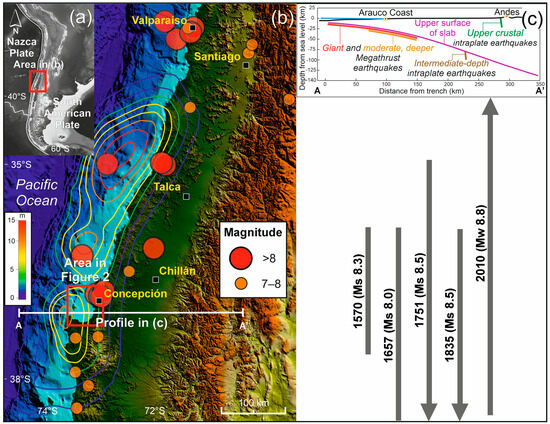
Figure 1.
(a) A subduction zone between the Nazca and South American plates characterizes the tectonic setting of Chile. (b) Rupture lengths of the most significant Megathrust earthquakes in the historical period 1570–2010 off the Gulf of Arauco coast in the 2010 Mw 8.8 Maule earthquake area [37]. (c) Slip distribution of the 2010 Maule earthquake (based on Moreno et al. [38]). Note the large earthquake slip of ~12 m below the Gulf of Arauco. Orange and red circles indicate the epicenters of earthquakes of Magnitude 7–8 and Magnitude 8+, respectively, in south-central Chile (https://www.csn.uchile.cl/sismologia/grandes-terremotos-en-chile/, accessed on 28 January 2025). The earthquakes originated in the three different faults shown in profile A-A’: Megathrust (interplate, red), Intermediate-depth (in the Nazca Plate, orange), and crustal (in the South American Plate, green) faults. The slab geometry is from Hayes et al. [39] and the topography from GEBCO [40].
This study employs LiDAR data and radargrams obtained from GPR survey lines to analyze the geomorphology and stratigraphy of the LCS, investigating the processes driving its Holocene development. By integrating high-resolution surface and subsurface data, we aim to elucidate the roles of tectonic uplift and past climate changes in shaping this strandplain. Our findings provide a scientific basis for understanding the response of a sandy coastal system to climate change and the seismic cycle, highlighting the LCS as a geomorphological singularity in an active tectonic setting.
2. Study Area
The LCS is a no-deltaic strandplain [41]. Bounded to the NNE by the Laraquete River, to the E by marine terraces, to the S by the Lia River, to the SSW by the Carampangue River, and to the W by the Pacific Ocean (orange box in Figure 2). The LCS lies along the coast overlooking the Gulf of Arauco in the Biobío Region, south-central Chile (red box in Figure 2). This coastal area forms a geomorphological system approximately 100 km long, featuring another strandplain to the north, the San Pedro-Escuadrón (SSPE in Figure 2). The coastal system developed through tectonic and eustatic processes, primarily shaping relative sea-level changes that governed its evolution during the Pleistocene and Holocene [42,43]. The geomorphological boundary between the Pleistocene and Holocene is marked by inactive cliffs separating uplifted marine terraces (Pleistocene) from the strandplain (Holocene). The inactive cliff exhibits evidence of marine erosion related to the mid-Holocene highstand [44] or last maximum marine transgression dating to ~7–6 ka BP [42,43]. After the mid-Holocene highstand, continuous relative sea-level decrease created accommodation space for the development of the LCS.
The current climate of the study area is controlled by the Southeast Pacific Anticyclone (SPA) and the migratory pressure systems of the circumpolar flow and band associated with frontal systems [45]. Holocene evidence in south-central Chile has shown a multi-millennial climatic variability of transition from drier (middle Holocene) to more humid conditions (late Holocene) [46,47,48,49,50,51,52,53,54] (see Table A1 in Appendix A). In front of the Gulf of Arauco, Francois et al. [55] suggest, based on the interpretation of sedimentological records from Laguna Verde (36°47′S, see Figure 2), that a local humid period was established from ~4 ka BP, resulting from a transition from a drier period established in the middle Holocene. Lamy et al. [56] suggest that this transition was primarily driven by the transfer of the southward and northward shifts of the Southern Westerly Wind Belt (SWW), respectively, which may have influenced the increase and decrease in SPA influence.
The coastal system is located in the southern section of the 2010 Maule earthquake (Mw 8.8) (Figure 1b,c). This event had a ~500 km rupture and a complex slip distribution with two maximum slip patches of ~17 m and ~12 m in the northern and southern sectors of the rupture, respectively (Figure 1b) [57,58]. The earthquake caused tsunami waves and land uplift on the mainland and Santa María Island in front of LCS [59] (see Figure 2). In Tubul, ~1.4 m of uplift was recorded (Figure 2), causing a widening of the beaches bordering ~100 m [60,61], while Santa María Island rose ~2.2 m, causing similar beach growth [22]. The predecessor to the 2010 Maule event was the 1835 earthquake, and comparable evidence, such as coastal uplift and tsunami inundation, suggests that both were similar (Ms 8.5, see Figure 1c) [38,59,62]. Charles Darwin studied its effects in situ and quantified coastal uplift based on dead mussels still attached to the emerged rocky shore, measuring an uplift of ~2.1 m at Tubul and ~3 m at Santa María Island [63]. This coseismic uplift also triggers beach growth. After the 2010 earthquake, vertical deformation was measured in the San Pedro-Escuadrón strandplain, the city of Coronel [64], and Santa María Island [12]. The subsidence is probably triggered because the coast facing the Gulf is in an interseismic phase, as it occurred after the 1835 earthquake [12,65].
The LCS is a populated coast, and the two main towns on its surface are Laraquete and Carampangue. The area has significant economic activities and infrastructures, such as a cellulose factory and a road. All these populated areas and activities have expanded at the expense of the strandplain and the dune field covering part of it. The above has implied a difficulty when studying its geomorphology and stratigraphy.
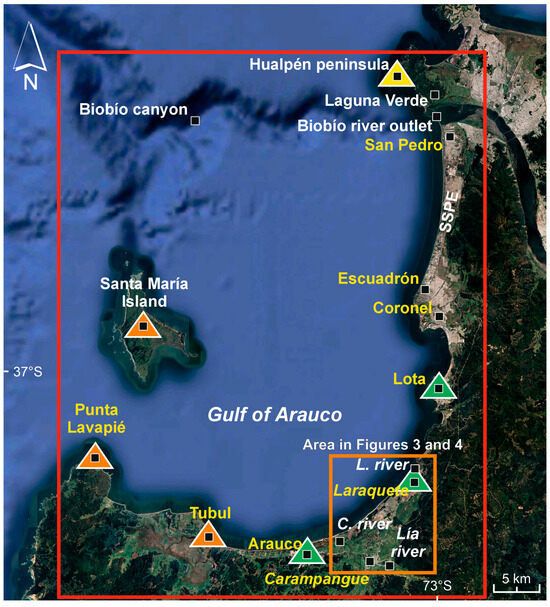
Figure 2.
Study area. The red box indicates the coastal and offshore area facing the Gulf of Arauco, which functions as a complex geomorphological system of which the LCS is part, whose location is indicated in the orange square. Triangles indicate areas uplifted during the 2010 Maule earthquake; orange indicates average measured uplift of 2.5 m, green indicates 1.5 m, and yellow indicates 1 m [66].
3. Materials and Methods
3.1. LiDAR Data and Other Remote Sensing Data
For accurate identification of coastal landforms, ground observations made in 2023, satellite images, an aerial photograph, and airborne Light Detection and Ranging (LiDAR) data obtained in 2008 were used. The LiDAR-derived point cloud data had a density of 2–4 points/m2 and was filtered to produce a Digital Terrain Model (DTM) with 1 m resolution. The DTM was processed using ArcMap 10.8 and Global Mapper Pro 23 software. Swath profiles based on LiDAR information were created using the Extract swath profiles tool of the ArcMap 10.8 software. The swath profile was made with a 500 m wide swath, considering profiles every 5 m. Both swath profiles, display the average elevation profile derived from LiDAR data (blue lines), the upper bound of elevations (orange lines), and the lower bound of elevations (green lines). The satellite images used in this work come from Google Earth Pro software for 2002, 2009, and 2023. The aerial photograph was obtained from a SAF (Chilean Aerial Photogrammetric Service) flight in 1979 at a scale of 1:30,000. The beach ridges counted were performed using the DTM in combination with aerial photographs and satellite images.
3.2. GPR and Terrain Data Collection
In 2023, GPR data were acquired using a GSSI UtilityScan system (manufactured by Geophysical Survey Systems Inc., Nashua, NH, USA) with a 350 MHz shielded, ground-coupled antenna, employing a sample interval of 0.02–0.03 m and an initial wave velocity of 0.15 m/ns in “dry sand” mode. Three longitudinal transects of varying lengths were conducted, resulting in three GPR profiles. Topographic correction was performed using an Emlid Reach RS2+ (manufactured by Emlid Tech Kft., Budapest, Hungary) differential GPS, with one antenna mounted on the GPR system in rover mode, compatible with the UtilityScan (https://www.geophysical.com/products/utilityscan, accessed on 15 December 2024). Radargrams were post-processed using Radan 7 software and the Matlab MatGPR R3 package [67], applying a standard routine with default settings: de-wow (desaturation), zero-time correction, horizontal background removal, gain functions, bandpass filtering, and topography correction.
To ensure accurate interpretation, we excavated a 1.6 m deep pit, as recommended by Pinegina et al. [27] and Switzer et al. [32], to correlate GPR reflections with facies and their composition. The pit revealed a stratigraphic profile of dry fine sand (0–60 cm), dry medium eolian sand (60–145 cm), a 5 cm wet silt–clay layer (145–150 cm), and dry medium eolian sand (150–160 cm). Depths of key interfaces (0.6 m, 1.45 m, 1.50 m) were measured and correlated with real-time radargram reflectors. A strong reflector at ~19.3 ns corresponded to the sand–silt–clay interface at 1.45 m, yielding a velocity of ~0.15 m/ns (v = (2 × 1.45)/(19.3 × 10−9)). A weaker reflector at ~8.0 ns aligned with the transition at 0.6 m (v = (2 × 0.6)/(8.0 × 10−9) ≈ 0.15 m/ns). A previous calibration at 1.0 m (13.3 ns) confirmed a velocity of 0.15 m/ns (v = (2 × 1.0)/(13.3 × 10−9)). Layer thicknesses were calculated by subtracting depths of adjacent reflectors (e.g., 60 cm for fine sand, 85 cm for medium sand from 60 to 145 cm). The 5 cm silt–clay layer was not resolvable due to the antenna’s vertical resolution (~11 cm in dry sand), but the pit confirmed its upper interface. The wet silt–clay’s high conductivity attenuated deeper reflections, yet the pit-validated facies (e.g., fine sand, wet silt–clay) and properties (texture, moisture). Depths matched pit measurements within a 5% error, ensuring robust results. Interpretation followed strandplain studies [21,28,29,31,68,69,70,71,72].
The location of the transects carried out to obtain the GPR profiles is justified to represent the modern and oldest landforms of the strandplain. The GPR1 profile was 400 m long, located north of the LCS, covering the current beach, the pre-2010 earthquake beach, and the vegetated dunes. The GPR2 profile was 75 m long and carried out in the coast’s center between the Carampangue and Laraquete rivers, covering the modern beach and the pre-2010 earthquake beach. The GPR3 line was 250 m long and was carried out inland, in the center of the LCS, covering three beach ridges (R1, R2, and R3) and three swales (S1, S2, and S3).
4. Results
4.1. LCS Geomorphology Revealed by LiDAR Data
LCS exhibits marine landforms, which are presented like a sequence of multiple beach ridges (Figure 3 and Figure 4); aeolian landforms represented by a vegetated dune field near the shoreline that decreases in width as it moves away from the Carampangue River (Figure 4); and fluvial landforms: a floodplain composed of a series of paleochannels and oxbows (yellow arrows in Figure 4) located between the strandplain and the marine terraces. A total of 52 beach ridges aligned in a SE–NW direction were counted, reflecting the orientation of the contemporary shoreline (Figure 3). Notably, a reservoir-corrected radiocarbon date of 7610 ± 90 years BP from Isla et al. [42] is immediately adjacent to ridge 1 (~200 m), confirming it as the earliest feature in this progradational succession. Comparable elevations, ranging from 5 to 6 m, are observed from ridge 1 (the earliest) to ridge 52 (the youngest) (see profiles A–A’ and B–B’ in Figure 3). DTM also reveals that the dune field apparently covers some ridges, as indicated by the orange arrows in Figure 4, at the boundary between the dune field and the beach ridges. Also, past fluvial activity, evidenced by the existence of the floodplain, has eroded the beach ridges. Patches of strandplain have become isolated due to fluvial erosion (red arrows in Figure 4 and Figure 5). The water source for these channels, which are mostly dry, comes from coastal basins, such as those found on marine terraces and the Cost Range.
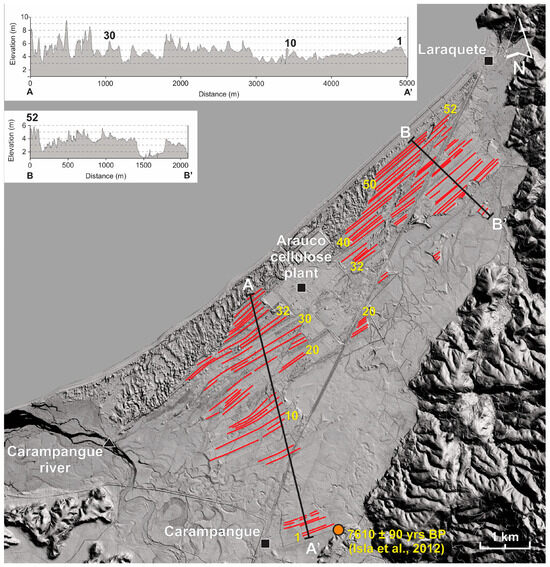
Figure 3.
Sequences of beach ridges (red lines) are identified in order of age. The oldest is ridge 1, the closest to the marine terrace, and the most recent is ridge 52, the closest to the coastline. The location of the radiocarbon dating (7610 ± 90 years BP, corrected for reservoir effect) from Isla et al. [42] is marked (orange dot), highlighting its proximity to Ridge 1, which supports the interpretation of this ridge as the oldest in the sequence. In addition to ridges 1 and 52, ridges 10, 20, 30, 40, and 50 are marked, as well as those that served as a guide for the correlation between lines, specifically ridge 32. The oldest ones were more difficult to identify due to their softer morphological condition than the most recent ones, an effect attributed to erosion. It is not ruled out that there could be more ridges that were not identified in the count. Profiles A-A’ and B-B’ show the altitude differences between some ridges identified in the strandplain, with ridges 1 and 52 standing out.
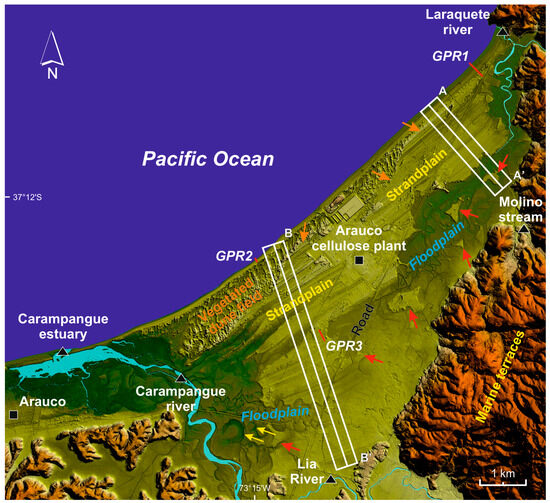
Figure 4.
DTM of LCS obtained from LiDAR data. Red arrows indicate patches of strandplain eroded by past fluvial activity. Yellow arrows indicate oxbows. Orange arrows indicate areas where vegetated dune fields cover beach ridges. Red lines represent GPR profiles.
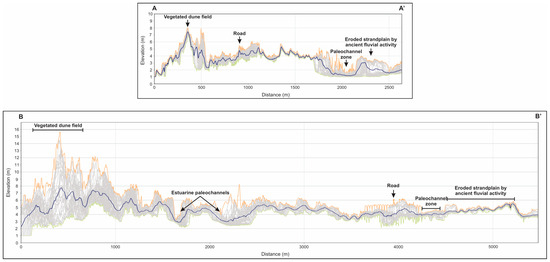
Figure 5.
Swath profiles (A-A’ and B-B’, 500 m wide) derived from LiDAR data, showing individual elevation profiles every 5 m (gray lines), the mean elevation profile (blue lines), the upper elevation limit (orange lines), and the lower elevation limit (green lines). Their location is shown in Figure 4. A-A’ profile represents the northeast area of LCS, and B-B’ profile represents the southwest area.
Swath profiles (A–A’ and B–B’, Figure 5) indicate that the strandplain does not exceed an average elevation of ~10 m, and the lowest zone is close to one-meter elevation, specifically in the paleochannel zone (e.g., ~1 m in A–A’ profile, Figure 5). The forest plantations on the vegetated dune reach more than ~15 m elevation, higher than the dune and the strandplain itself (B-B’ profile, Figure 5). Also, the swath profiles show that the dunes interlock with the beach ridges, covering them and increasing the altitude of the LCS (Figure 5).
The 1979 aerial photograph (Figure 6a) confirms the bare dunes and sand sheets covering the strandplain. The dune morphology and the lack of vegetation cover indicate that they were active and advancing at the time. The direction of their movement derived from their transverse axis suggests that their sediment source was directly the river and not the sea (black arrows in Figure 6b). The direction of their movement derived from their transverse axis suggests that their sediment source was directly the river and not the sea (black arrows in Figure 6b). This is corroborated by observing the wind rose obtained for the area (Figure 6c), which shows effective wind speeds for transporting sand-sized sediment (>4.5 m/s) and coming mainly from the S, i.e., precisely from the river. The width of the dune field decreases towards the NE, from ~1200 to ~100 m, over a ~10 km extension towards Laraquete (see Figure 4), suggesting that its main sediment source is the Carampangue River. Sand sheets free of vegetation covered beach ridges and swales, including our pit, implying that part of the river sediment was advancing inland in a dispersed deflation process (orange arrows in Figure 6a).
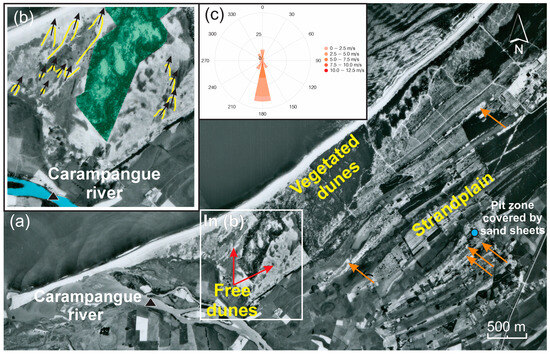
Figure 6.
Dunes in LCS. (a) Orange arrows indicate aeolian landforms (sand sheets and dunes) covering beach ridges, and the light blue circle shows the location of the pit, which in 1979 had a sand sheet on the surface. (b) Yellow lines indicate bare dune ridges, parabolic and barchan, with an advance axis in an NE direction represented by black arrows. In green, a forest management area is indicated to control dune advance. (c) Wind rose representative of the area (reconstruction of data from 1980 to 2017, https://eolico.minenergia.cl/exploracion, accessed on 15 January 2024) shows the preferred direction of the effective winds for dunes (over 4.5 m/s) from the S. Source: Author’s elaboration based on SAF (Chilean Aerial Photogrammetric Service) 1979 aerial photography.
4.2. LCS Stratigraphy Revealed by Radargrams Obtained from GPR Survey Lines
The Mw 8.8 Maule earthquake on 27 February 2010, generated coseismic uplifts in the study area and triggered beach growth, forming new shorefaces, beachfaces, berms, and backshore. Thus, the earthquake provided an excellent opportunity to review modern analogs of recent beach facies with GPR because it allowed the pre-earthquake beach to be removed from the marine environment and away from salt water (electromagnetic waves are disturbed by salt water). Changes in the shoreface and the runnel located on the backshore can be seen in satellite images from 2002 and 2023, when the GPR profiles were taken (Figure 7b). The pre-earthquake parts of the beach were identified (marked with an asterisk in Figure 7a), serving as an analog for analyzing the facies found further inland.
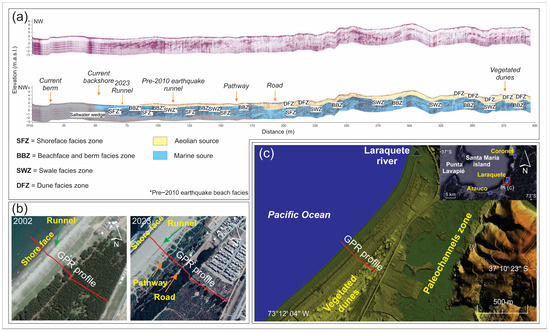
Figure 7.
GPR1 profile. In (a), the facies interpretation is shown in colors and with legends. In (b), the green arrows show pre-earthquake and 2023 runnels. Like a shoreface, this runnel and other beach structures are buried under a sand sheet and associated with a SWZ (planiform and/or convex reflectors). In 2023, another runnel was formed, showing the same structural characteristics as the pre-earthquake runnel (planiform and/or convex reflectors). In (c), the location of the GPR profile over the vegetated dunes and the paleochannel zone is shown.
Sand sheet with a thickness < 1 m is seen from the back beach to the pathway (between ~80 and ~180 m), which then increases in thickness to more than 1 m towards the inland, up to almost ~400 m (Figure 7a). Underlying deposits of marine origin with shoreface facies zones (SFZ) and beachface and berm facies zones (BBZs) are present in pairs up to the road (Figure 6a and Figure 7a). After the road, the SFZ disappeared, possibly because they could not be recorded due to the dissipation of the GPR waves and/or the presence of salt water. Also, dune facies zones (DFZs) begin to be seen from the path, which become more regular in the last ~70 m of the profile.
The GPR2 profile in Figure 8a shows a configuration similar to the first ~120 m of the radargram in Figure 7a. The SFZ and BBZ are shown in sequences of alternating pairs, and at a certain point, at ~40 m, where the rear beach ends, they are covered by a sand sheet. Unlike the GPR1 profile area, where the beach was wider (~80 m), the beach identified in the GPR2 profile was narrower (~40 m). The SFZ and BBZ facies prior to the earthquake (with an asterisk in Figure 8a) were found to be more compressed or close together (up to ~60 m) than the GPR1 radargram (up to ~115 m, with an asterisk in Figure 7a). Satellite images confirm the formation of a new post-earthquake shoreface, identified as SFZ at ~15 m (Figure 8b). Also, the radargram shows that the sand sheets do not exceed ~1 m in thickness.
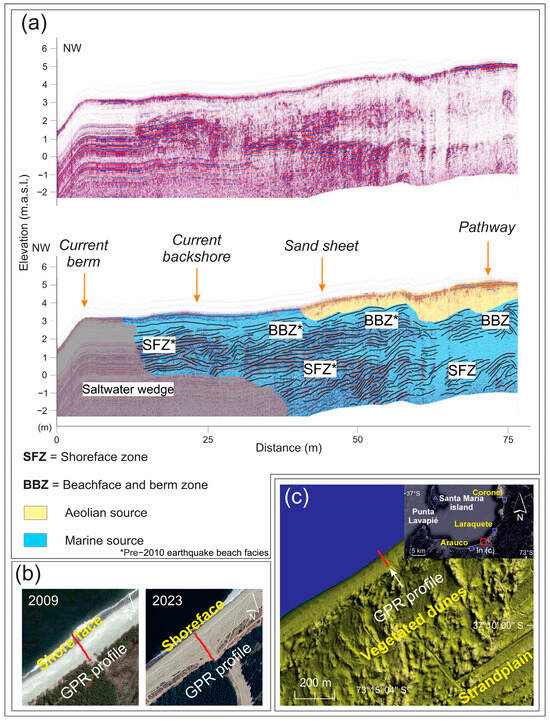
Figure 8.
GPR2 profile. In (a), the facies are shown in colors and with legends. In (b), the location of the shoreface before the earthquake and in 2023 is shown. A change in the location of the shoreface and the extension of the beach was caused by the 2010 earthquake, and sand sheets covered the pre-earthquake beach structures. In (c), the location of the GPR line concerning the vegetated dunes and the strandplain is shown.
The GPR3 profile in Figure 9a was acquired approximately ~2.3 km inland within the strandplain to investigate paleofacies, using modern analogs derived from the radargrams presented in Figure 7a and Figure 8a. The profile reveals low-relief aeolian structures characteristic of sand sheets, with localized occurrences of dune facies zones (DFZs) exhibiting a maximum thickness of approximately ~2 m (Figure 10). Within the uppermost ~60 cm, a poorly developed soil is observed, characterized by silty clay textures, oxidized sands, and the presence of roots. This transitions to predominantly medium-grained sand below a depth of 1 m. Additionally, a silt layer, approximately ~5 cm thick, is identified at a depth of about ~150 cm (Figure 10). This layer likely represents a deposit formed by stagnant water or a limnic process, commonly observed in low-lying coastal topographic features, such as interdune depressions (e.g., interdune ponds).
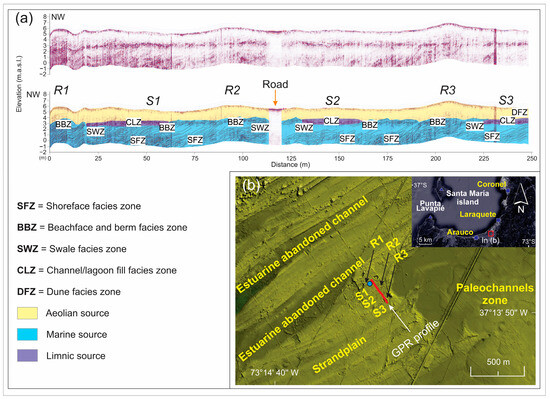
Figure 9.
GPR3 profile. In (a), the letters R (1,2 and 3) are interpreted as beach ridges covered by aeolian features, while the letters S (1, 2, and 3) are interpreted as swales or depressions between ridges. In (b), the location of the GPR line over the vegetated dunes and the strandplain is shown. The light blue dot represents the location of the pit visible in Figure 10.
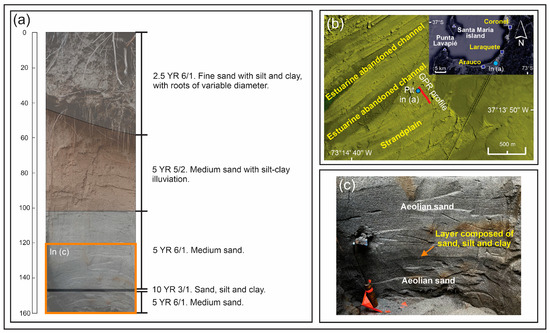
Figure 10.
(a–c) Pit near the GPR3 profile used to control the data observed in the radargrams.
Below the strata of aeolian origin, marine deposits corresponding to SFZ, BBZ, and swale facies zones or SWZ are observed. The SFZ and BBZ structures occur in paired sequences, resembling modern analogs of recent beaches (see Figure 7a and Figure 8a), indicating that each shoreface is associated with a corresponding beachface and berm zone. In swale-dominated zones (beneath S1 and S2), the SFZ and BBZ are spatially compressed, whereas in ridge-dominated zones (beneath R2 and R3), they are more widely separated and extensively developed. Additionally, beneath the ridges (R1, R2, and R3), the BBZ structures attain a greater vertical extent.
Furthermore, the radargram reveals an area characterized by sub-horizontal to slightly concave, semi-continuous, and compact reflectors associated with swales S1, S2, and S3. These reflectors are identified as channel-and-lagoon fill zones (CLZs) of lacustrine origin. This interpretation is particularly significant within the sedimentological and geomorphological context of inter-ridge depressions, where these zones are situated above marine deposits and below aeolian deposits. These depressions are also adjacent to abandoned estuarine channels, which may have flooded the area during their active phase, indicating a depositional environment characterized by increased humidity. Consequently, the CLZ likely represents lagoons or stagnant water bodies where sand and finer sediments, such as silt, were deposited. This is consistent with observations from the pit shown in Figure 10, although the CLZ exhibits greater thickness.
5. Discussion
5.1. Holocene Sedimentation, Erosion and Evolution of the LCS
The geomorphological analysis, based on LiDAR data and GPR profile interpretation, reveals that the LCS has been primarily formed through a combination of marine and aeolian sedimentation processes, in which dunes and sand sheets have overlain landforms such as beach ridges. Our data indicate that these beach ridges are associated with aeolian landforms, configuring the system as a marine–aeolian plain, consistent with observations from various global coastal settings [1,2,3]. Local studies provide inferred age estimates for the onset of beach ridge formation to constrain the Holocene evolution of the LCS. Notably, the inactive cliff exhibits evidence of marine erosion related to the mid-Holocene highstand [44] or the last maximum marine transgression, dated to approximately 7–6 ka BP [42,43], which likely marks the initiation of strandplain progradation. A reservoir-corrected radiocarbon date of 7610 ± 90 years BP from Isla et al. [42], obtained from shell material in the Carampangue coastal plain approximately 200 m from the identified ridge 1 (the oldest ridge in our sequence), aligns closely with this transgressive phase, supporting the interpretation of ridge 1 as the earliest feature and implying that major beach ridge accretion began around this time. This timing coincides with drier climatic conditions during the Middle Holocene that favored marine sedimentation and ridge preservation [46,47,48,49,50,51,55,73]. Past fluvial processes, associated with wetter climatic phases, have reconfigured the strandplain through erosion, thereby reducing its extent.
The drainage network, originating from the marine terraces and the Coast Range, has significantly influenced the strandplain’s evolution for two primary reasons: first, it has delivered sediments to the system [74]; and second, it has eroded the strandplain, as indicated by the development of floodplains with paleochannels that have incised the beach ridges. These eroded ridges indicate that the strandplain was once more extensive, initially dominated by marine sedimentation but later modified by fluvial activity in specific sectors. Therefore, Holocene evidence in south-central Chile, including our LCS data, has shown a multi-millennial climatic variability transitioning from drier (Middle Holocene) to more humid conditions (Late Holocene). In the LCS, this is directly supported by LiDAR-mapped beach ridges preserved under initial drier conditions and subsequently eroded by a denser fluvial network during wetter phases, as confirmed by GPR facies showing progradational-to-erosional transitions. Climatic variations in south-central Chile, with drier conditions during the Middle Holocene and wetter conditions in the Late Holocene compared to the present [46,47,48,49,50,51,55,73] (see Table A1 in Appendix A), have further modulated this evolution. Drier phases likely favored the formation and preservation of beach ridges, whereas wetter phases promoted a denser and more active drainage network than the present-day network.
5.2. Climatic Signatures in Sedimentary Facies
Phases of higher humidity are inferred from sedimentary facies visible in the radargrams, specifically in the GPR3 profile, obtained at ~2.3 km from the coast. This profile reveals reflector packages (CLZ) distinct from aeolian and marine origin facies, coinciding with geomorphologically depressed zones or swales. The reflectors have a medium to low amplitude, are compact, semicontinuous, subhorizontal, and are eventually slightly concave. These layers represent changes or alterations in the sedimentation regimes in the strandplain and can be directly associated with changes in the climate [17,70]. The CLZ deposits suggest a limnic origin, like areas of recurrent flooding, swamps with coastal vegetation development, and accumulation of organic remains associated with soil layers containing silt and clay (e.g., peat) [17,21,68,70]. It is important to note that the GPR3 profile is close to an estuarine abandoned channel (formed in wetter conditions, see Figure 9), which could have supplied water and humidity in wetter phases (see Table A1 in Appendix A) to the swale, keeping the water table high or near the surface.
Furthermore, the CLZs, despite being separated by distances of tens of meters (see Figure 9), are found at a similar altitude (between 2 and 3 m), which may serve as indicators of past coastal water table levels. In addition, subhorizontal and semicontinuous reflectors are observed in the backshores and runnels of the GPR1 and GPR2 profiles, corresponding to depressed areas downwind of the berms. These facies, typical of such areas, form part of the washover deposits [21,71,72]. When these depressed areas are no longer influenced by marine processes (e.g., triggered by tectonic uplift), they may develop into swale zones. Over time, the areas may become flooded, forming lagoons and swamps, with subsequent development of vegetation and even soils, generating facies similar to those observed in the CLZ (e.g., [17,70]).
5.3. Origin and Dynamics of Dune Field
The dune field north of the Carampangue River decreases in width as it extends away from the river, indicating that the river is its primary sediment source. Our data show that the dune fields are not present in the interior of the strandplain but instead form a sand sheet that covers the crests of the beach in some areas (e.g., Figure 6). These observations suggest that their presence results from an environmental change that promoted their formation and expansion. The primary factor for the formation and growth of dune fields is the availability of dry sand alongside sufficient space and effective wind (e.g., [75]). This indicates that the Carampangue River, the primary sediment source in the study area [74], either did not deliver sufficient sediment or local environmental conditions were not conducive to generating accumulation until a shift in these conditions occurred. According to our results, while the effective wind is present today (see Figure 6), the supply of dry sand from the river remains limited. Albert studied this dune field in 1900 [76], classifying it as one of the most active in central-southern Chile during the 19th century. This significantly affected local productive activity and critical infrastructure, so the locals had to control it with pine species (e.g., Pinus insignis). Notably, Albert dates the origin of dune fields in the region to 70 to 90 years before his work (1900). Thus, before the first half of the 19th century, there was no record of dune formation and activity in this area of Arauco that would affect the local population.
The last significant phase of global climate change before the 20th century was the Little Ice Age (LIA), which occurred between the 14th and 19th centuries [73]. In south-central Chile, the LIA was characterized by increased rainfall and flooding, persisting until at least the first half of the 19th century (e.g., [47,48,54,77]). However, some studies suggest that the LIA also featured dry conditions interspersed with wetter periods [73], a variability that likely influenced sediment dynamics. Consequently, the alternation between high-humidity phases and drought may have created conditions conducive to dune field formation. This could be explained by the fact that, despite high-humidity conditions over the last 2 ka BP ascending in south-central Chile, which likely produced abundant sand-sized sediment, this sediment could only contribute to dune field formation if it remained dry for a sufficiently prolonged period to be transported and accumulated [75]. Such conditions were likely facilitated by periods of drought when sediment remained available in the system. These optimal conditions may have been particularly pronounced during the waning phase of the LIA in the first half of the 19th century, as humidity gradually decreased, allowing sediment to remain dry for extended periods. In addition to climatic factors, tectonic events may have further contributed to dune formation, as the 1835 earthquake (Ms 8.5, see Figure 1c), similar to the 2010 earthquake, caused seismic uplift [65] that likely expanded the size of the beaches. Consequently, the increased surface area facilitated the deposition and accumulation of sand, which was subsequently transported inland by wind to form the dunes.
A similar geomorphological situation has been registered in Santa María Island, located 25 km seaward, where high dune ridges (~3 m) are present near the coastline within a strandplain dominated by beach ridges, with the absence of dune fields inland. Aedo et al. [12] recorded the exceptional presence of these dunes and dated their maximum formation age of 170 years ± 15 BP (see Figure S10 in [12]) without identifying their specific origin. A comparable situation is observed in the Moruya strandplain in Australia, highlighting the presence of anomalous dune crests close to the coastline, which contrasts with 7 ka years of the formation of beach ridges dominant on the surface that were formed in the mid-nineteenth century [31,69]. This mid-nineteenth-century timing aligns with the waning phase of the Little Ice Age and the 1835 earthquake discussed earlier, suggesting that a combination of climatic and tectonic factors facilitated dune formation across the region. These antecedents, combined with the observations of Albert [76] and the evidence collected in this study, provide a temporal context for relatively dating the formation of the dune field in the study area. As such, this interpretation remains a hypothesis that integrates multiple lines of evidence to highlight a potential temporal coincidence with the LIA’s end, which may or may not indicate direct causation and requires future corroboration or refutation through targeted studies. However, further research is needed, including collecting more data in the LCS and analogs in other coastal zones of Chile and the southern hemisphere and acquiring absolute dating data.
5.4. Tectonic Influence on Coastal Accretion
Although the marine facies indicate the presence of ancient beaches undergoing constant accretion or progradation during at least the Middle and Late Holocene, the local sediment supply conditions are not conducive to forming a strandplain with the characteristics of the LCS. This can be attributed to the fact that its primary sediment source, the coastal basin of the Carampangue River, is a small basin (~1260 km2) with a low sediment supply potential, as evidenced by its relatively modest average discharge of ~60 m3/s [78], compared to the Andean basins of south-central Chile and particularly compared to basins associated with other strandplains of similar characteristics [41]. For instance, the Biobío River, an Andean basin within the study area, has a much larger basin area of ~24,000 km2 and an average discharge of ~640 m3/s (measured at the mouth) [79]. This contrast, with a basin size approximately 19 times smaller and a discharge over 10 times lower for the Carampangue River, suggests that the LCS’s extensive progradation relies on recurrent tectonic uplift events, such as those in 1835 and 2010, rather than fluvial sediment supply, unlike typical strandplains sustained by larger river systems.
The evidence presented in this study suggests that the Holocene accretion condition of this plain is fundamentally due to the tectonic conditions of coseismic uplift and beach growth during large earthquakes. The keys to this tectonic accretion of the beach were provided by the February 2010 earthquake, which, as seen in Figure 5 and Figure 6, caused coseismic beach growth of tens of meters. Added to this is the event of its predecessor in 1835, which also triggered an uplift [62] that must have also resulted in beach accretion, and the net uplift recorded for the study area during the Holocene, which reinforces the idea that the presence of the LCS is primarily due to the seismic cycle. Our interpretations are based on LiDAR data acquired in 2008, before the 2010 Maule earthquake, which effectively captures the pre-event topography and long-term Holocene geomorphological patterns accumulated over millennia. While the 2010 event induced coseismic uplift (1–2 m in the Arauco coast) and subsequent beach progradation, these changes primarily affected the modern coastline and nearshore zones, as documented in post-event studies (e.g., [65,66]). The preserved beach ridges and subsurface facies identified in our LiDAR and GPR analyses reflect deeper Holocene structures that predate 2010 and remain representative of tectonic-driven accretion, with minimal overprinting by the recent uplift on the interpreted erosional and depositional sequences. Similarities between the altitudes of the oldest and youngest ridges (see Figure 3) could complicate the interpretation of a net uplift rate in the LCS, considering that the older a ridge is, the higher its elevation. However, as recorded in the study area, erosion must be considered, as it lowers and softens the shapes (see Figure 3 caption). It is therefore necessary to verify this tectonic influence in other coastal plains in Chile with limited sediment supply from coastal basins. While tectonic processes dominate, this study has demonstrated that climatic forcing also plays a significant role in the evolution of such tectonically active sandy coasts.
A key limitation of using the 2008 DTM is the potential for post-2010 geomorphic overprinting on nearshore features, such as beach widening, which could subtly influence interpretations of the youngest ridges’ morphology or recent accretion rates. However, since our focus is on Holocene-scale evolution (e.g., multi-millennial progradation and erosion), these changes do not substantially alter the overall patterns of older features, as the uplift’s effects are localized to the active coastline and do not retroactively modify pre-served interior ridges or subsurface facies. Future studies incorporating post-2010 LiDAR or satellite imagery could quantify these influences more precisely.
6. Conclusions
This study employed airborne LiDAR and ground-coupled GPR with a 350 MHz shielded antenna to investigate the Holocene evolution of the Laraquete-Carampangue strandplain (LCS) in south-central Chile. LiDAR-derived digital terrain models and GPR radargrams revealed a complex interplay of marine, aeolian, and fluvial processes, with 52 beach ridges partially covered by sand sheets and dunes, eroded by paleochannels, and interspersed with limnic facies zones (CLZs) indicating wetter Late Holocene conditions. The dune field, formed in the early 19th century, reflects climatic variability during the Little Ice Age and coseismic uplift from the 1835 and 2010 earthquakes, which drove significant beach accretion despite limited sediment supply from the Carampangue River. These findings highlight the critical role of tectonic uplift in sustaining strandplain development in sediment-scarce active margins, complemented by climatic influences on sedimentation dynamics. The integration of high-resolution LiDAR and GPR datasets provides a robust framework for reconstructing coastal evolution, offering insights into the response of sandy coastal systems to tectonic and climatic forcings, with broader implications for predicting coastal resilience under ongoing environmental changes.
Author Contributions
C.A.-C.: conceptualization, methodology, data acquisition, software, validations, formal analysis, original draft and visualization. D.A.: methodology, data acquisition, software, validations, review and editing. C.M.: conceptualization, review and editing, supervision and funding. D.M.: methodology, review and editing, and funding. All authors have read and agreed to the published version of the manuscript.
Funding
This research was funded by Agencia Nacional de Investigación y Desarrollo through ANID-FONDECYT N◦1241922 and Instituto Milenio en Socio-ecología Costera (SECOS) ICN2019_015.
Data Availability Statement
The original contributions presented in the study are included in the article, further inquiries can be directed to the corresponding author.
Acknowledgments
The CYCLO project. LiDAR data was provided by Forestal Arauco to the CYCLO project.
Conflicts of Interest
The authors declare no conflicts of interest.
Appendix A
Table of Climate Changes in South-Central Chile During the Middle and Late Holocene

Table A1.
Studies show dry/humid phases of the Holocene climate in the Intermediate Depression and the Coastal Zone of south-central Chile. These are not considered transitional phases, and their boundaries with the dry/humid phases are difficult to establish.
Table A1.
Studies show dry/humid phases of the Holocene climate in the Intermediate Depression and the Coastal Zone of south-central Chile. These are not considered transitional phases, and their boundaries with the dry/humid phases are difficult to establish.
| Study Authors | Proxy | Location (Lat) | Type of Period (Drier or Wetter, Possibly than Present) | Ages |
|---|---|---|---|---|
| Maldonado and Villagrán [52] | Pollen dating in paleo swamps and forests | 32°S | Dry period | 8.7–5.7 ka BP |
| Frugone-Álvarez et al. [51] | Multiple proxies dating in lake sediments (Vichuquén Lake) | 34°50′S | Dry period | 7–6.2 ka BP |
| Jenny et al. [48]; Villa-Martínez et al. [49] | Multiple proxies dating in lagoon sediments (Aculeo Lake) | 33°50′S | Dry period | 5.7 ka BP |
| Lamy [46] | Multiple proxies dating in continental slope sediments | 33°S | Dry period | 5.5 ka BP |
| Sterken et al. [50] | Multiple proxies dating in lake sediments (Puyehue Lake) | 40°S | Dry period | 8.1–5 ka BP |
| Francois et al. [55] | Pollen dating in lagoon sediments (Aculeo Lake) | 36°47′S | Wet period | 4 ka BP–close to the present |
| Villa-Martínez and Villagrán [53] | Pollen dating in paleo swamps and forests | 32°S | Wet period | 2 ka BP–close to the present (ca. 1400–1600 a.c. wetter than present) |
| Jenny et al. [48] | Pollen dating in lagoon sediments (Aculeo Lake) | 33°50′S | Wet period | 2.2 ka BP–close to the present |
| Bertrand et al. [54] | Multiple proxies dating in lake sediments (Puyehue Lake) | 40°S | Wet period | ca. 1490 y 1700 d.c. (wetter than present) |
References
- Roy, P.S.; Cowell, P.J.; Ferland, M.A.; Thom, B.G. Wave-dominated coasts. In Coastal Evolution: Late Quaternary Shoreline Morphodynamics; Cambridge University Press: Cambridge, UK, 1994; pp. 121–186. [Google Scholar]
- Otvos, E.G. Beach Ridges—Definitions and Significance. Geomorphology 2000, 32, 83–108. [Google Scholar] [CrossRef]
- Neal, A.; Richards, J.; Pye, K. Sedimentology of coarse-clastic beach-ridge deposits, Essex, southeast England. Sediment Geol. 2003, 162, 167–198. [Google Scholar] [CrossRef]
- Kinsela, M.A.; Daley, M.J.A.; Cowell, P.J. Origins of Holocene Coastal Strandplains in Southeast Australia: Shoreface Sand Supply Driven by Disequilibrium Morphology. Mar. Geol. 2016, 374, 14–30. [Google Scholar] [CrossRef]
- Dillenburg, S.R.; Hesp, P.A. Geology and Geomorphology of Holocene Coastal Barriers of Brazil; Springer Science & Business Media: Berlin/Heidelberg, Germany, 2009; Volume 107. [Google Scholar]
- Oliver, T.S.N.; Tamura, T.; Brooke, B.P.; Short, A.D.; Kinsela, M.A.; Woodroffe, C.D.; Thom, B.G. Holocene Evolution of the Wave-Dominated Embayed Moruya Coastline, Southeastern Australia: Sediment Sources, Transport Rates and Alongshore Interconnectivity. Quat. Sci. Rev. 2020, 247, 106566. [Google Scholar] [CrossRef]
- FitzGerald, D.M.; Cleary, W.J.; Buynevich, I.V.; Hein, C.J.; Klein, A.H.F.; Asp, N.; Angulo, R. Strandplain Evolution along the Southern Coast of Santa Catarina, Brazil. J. Coast. Res. 2007, 152–156. [Google Scholar]
- Woodroffe, C.D. Coasts: Form, Process and Evolution; Cambridge University Press: Cambridge, UK, 2002. [Google Scholar]
- Scheffers, A.; Engel, M.; Scheffers, S.; Squire, P.; Kelletat, D. Beach Ridge Systems—Archives for Holocene Coastal Events? Prog. Phys. Geogr. Earth Environ. 2012, 36, 5–37. [Google Scholar] [CrossRef]
- Nelson, A.R.; Manley, W.F. Holocene Coseismic and Aseismic Uplift of Isla Mocha, South-Central Chile. Quat. Int. 1992, 15, 61–76. [Google Scholar] [CrossRef]
- Monecke, K.; Templeton, C.K.; Finger, W.; Houston, B.; Luthi, S.; McAdoo, B.G.; Sudrajat, S.U. Beach Ridge Patterns in West Aceh, Indonesia, and Their Response to Large Earthquakes along the Northern Sunda Trench. Quat. Sci. Rev. 2015, 113, 159–170. [Google Scholar] [CrossRef]
- Aedo, D.; Melnick, D.; Cisternas, M.; Brill, D. Tectonic Control on Great Earthquake Periodicity in South-Central Chile. Commun. Earth Environ. 2024, 5, 703. [Google Scholar] [CrossRef]
- Tamura, T. Beach Ridges and Prograded Beach Deposits as Palaeoenvironment Records. Earth Sci. Rev. 2012, 114, 279–297. [Google Scholar] [CrossRef]
- Hede, M.U.; Bendixen, M.; Clemmensen, L.B.; Kroon, A.; Nielsen, L. Joint Interpretation of Beach-Ridge Architecture and Coastal Topography Show the Validity of Sea-Level Markers Observed in Ground-Penetrating Radar Data. Holocene 2013, 23, 1238–1246. [Google Scholar] [CrossRef]
- Silva, A.P.; Klein, A.H.F.; Fetter-Filho, A.F.H.; Hein, C.J.; Méndez, F.J.; Broggio, M.F.; Dalinghaus, C. Climate-Induced Variability in South Atlantic Wave Direction over the Past Three Millennia. Sci. Rep. 2020, 10, 18553. [Google Scholar] [CrossRef]
- FRASER, C.; HILL, P.R.; ALLARD, M. Morphology and Facies Architecture of a Falling Sea Level Strandplain, Umiujaq, Hudson Bay, Canada. Sedimentology 2005, 52, 141–160. [Google Scholar] [CrossRef]
- Hein, C.J.; Fitzgerald, D.M.; Cleary, W.J.; Albernaz, M.B.; De Menezes, J.T.; da F. Klein, A.H. Evidence for a Transgressive Barrier within a Regressive Strandplain System: Implications for Complex Coastal Response to Environmental Change. Sedimentology 2013, 60, 469–502. [Google Scholar] [CrossRef]
- Dillenburg, S.R.; Barboza, E.G.; Rosa, M.L.C.C.; Caron, F.; Sawakuchi, A.O. The Complex Prograded Cassino Barrier in Southern Brazil: Geological and Morphological Evolution and Records of Climatic, Oceanographic and Sea-Level Changes in the Last 7–6 Ka. Mar. Geol. 2017, 390, 106–119. [Google Scholar] [CrossRef]
- Kelsey, H.M.; Witter, R.C.; Engelhart, S.E.; Briggs, R.; Nelson, A.; Haeussler, P.; Corbett, D.R. Beach Ridges as Paleoseismic Indicators of Abrupt Coastal Subsidence during Subduction Zone Earthquakes, and Implications for Alaska-Aleutian Subduction Zone Paleoseismology, Southeast Coast of the Kenai Peninsula, Alaska. Quat. Sci. Rev. 2015, 113, 147–158. [Google Scholar] [CrossRef]
- Pitman, S.J.; Jol, H.M.; Shulmeister, J.; Hart, D.E. Storm Response of a Mixed Sand Gravel Beach Ridge Plain under Falling Relative Sea Levels: A Stratigraphic Investigation Using Ground Penetrating Radar. Earth Surf. Process. Landf. 2019, 44, 1610–1617. [Google Scholar] [CrossRef]
- Prasad, P.; Loveson, V.J.; Kumar, V.; Shukla, A.D.; Chandra, P.; Verma, S.; Yadav, R.; Magotra, R.; Tirodkar, G.M. Reconstruction of Holocene Relative Sea-Level from Beach Ridges of the Central West Coast of India Using GPR and OSL Dating. Geomorphology 2023, 442, 108914. [Google Scholar] [CrossRef]
- Aedo, D.; Cisternas, M.; Melnick, D.; Esparza, C.; Winckler, P.; Saldaña, B. Decadal Coastal Evolution Spanning the 2010 Maule Earthquake at Isla Santa Maria, Chile: Framing Darwin’s Accounts of Uplift over a Seismic Cycle. Earth Surf. Process. Landf. 2023, 48, 2319–2333. [Google Scholar] [CrossRef]
- Nielsen, L.; Clemmensen, L.B. Sea-level Markers Identified in Ground-penetrating Radar Data Collected across a Modern Beach Ridge System in a Microtidal Regime. Terra Nova 2009, 21, 474–479. [Google Scholar] [CrossRef]
- Clemmensen, L.B.; Nielsen, L. Internal Architecture of a Raised Beach Ridge System (Anholt, Denmark) Resolved by Ground-Penetrating Radar Investigations. Sediment. Geol. 2010, 223, 281–290. [Google Scholar] [CrossRef]
- Costas, S.; Ferreira, Ó.; Plomaritis, T.A.; Leorri, E. Coastal Barrier Stratigraphy for Holocene High-Resolution Sea-Level Reconstruction. Sci. Rep. 2016, 6, 38726. [Google Scholar] [CrossRef]
- da Rocha, T.B.; Fernandez, G.B.; de Oliveira Peixoto, M.N. Applications of Ground-Penetrating Radar to Investigate the Quaternary Evolution of the South Part of the Paraiba Do Sul River Delta (Rio de Janeiro, Brazil). J. Coast. Res. 2013, 65, 570–575. [Google Scholar] [CrossRef]
- Pinegina, T.K.; Bourgeois, J.; Bazanova, L.I.; Zelenin, E.A.; Krasheninnikov, S.P.; Portnyagin, M.V. Coseismic Coastal Subsidence Associated with Unusually Wide Rupture of Prehistoric Earthquakes on the Kamchatka Subduction Zone: A Record in Buried Erosional Scarps and Tsunami Deposits. Quat. Sci. Rev. 2020, 233, 106171. [Google Scholar] [CrossRef]
- Rodríguez-Santalla, I.; Gomez-Ortiz, D.; Martín-Crespo, T.; Sánchez, M.J.; Montoya-Montes, I.; Martín-Velázquez, S.; Barrio, F.; Serra, J.; Ramírez-Cuesta, J.M.; Gracia, F.J. Study and Evolution of the Dune Field of La Banya Spit in Ebro Delta (Spain) Using LiDAR Data and GPR. Remote Sens. 2021, 13, 802. [Google Scholar] [CrossRef]
- Brooke, B.P.; Huang, Z.; Nicholas, W.A.; Oliver, T.S.N.; Tamura, T.; Woodroffe, C.D.; Nichol, S.L. Relative Sea-Level Records Preserved in Holocene Beach-Ridge Strandplains—An Example from Tropical Northeastern Australia. Mar. Geol. 2019, 411, 107–118. [Google Scholar] [CrossRef]
- Ciarletta, D.J.; Shawler, J.L.; Tenebruso, C.; Hein, C.J.; Lorenzo-Trueba, J. Reconstructing Coastal Sediment Budgets From Beach- and Foredune-Ridge Morphology: A Coupled Field and Modeling Approach. J. Geophys. Res. Earth Surf. 2019, 124, 1398–1416. [Google Scholar] [CrossRef]
- Tamura, T.; Oliver, T.S.N.; Cunningham, A.C.; Woodroffe, C.D. Recurrence of Extreme Coastal Erosion in SE Australia Beyond Historical Timescales Inferred from Beach Ridge Morphostratigraphy. Geophys. Res. Lett. 2019, 46, 4705–4714. [Google Scholar] [CrossRef]
- Switzer, A.D.; Gouramanis, C.; Bristow, C.S.; Simms, A.R. Ground-Penetrating Radar (GPR) in Coastal Hazard Studies. In Geological Records of Tsunamis and Other Extreme Waves; Elsevier: Amsterdam, The Netherlands, 2020; pp. 143–168. [Google Scholar]
- Doyle, T.B.; Woodroffe, C.D. The Application of LiDAR to Investigate Foredune Morphology and Vegetation. Geomorphology 2018, 303, 106–121. [Google Scholar] [CrossRef]
- Angermann, D.; Klotz, J.; Reigber, C. Space-Geodetic Estimation of the Nazca-South America Euler Vector. Earth Planet Sci. Lett. 1999, 171, 329–334. [Google Scholar] [CrossRef]
- Davis, R.A. 10.16 Evolution of Coastal Landforms. Treatise Geomorphol. 2013, 10, 417–448. [Google Scholar] [CrossRef]
- Araya-Vergara, J.F. Análisis de La Localización de Los Procesos y Formas Predominantes de La Linea Litoral de Chile: Observación Preliminar. Investig. Geográficas Una Mirada Desde 1982, 29, 35–55. [Google Scholar] [CrossRef]
- San Martín, J.; Calisto, I.; Quezada, J.; Stewart, D.; Ely, L.; Cifuentes-Lobos, R.; Moreno, M. Characterization of Historical Megathrust Earthquake Ruptures in Central Chile Using Logic Tree Analysis. Nat. Hazards 2024, 120, 5411–5427. [Google Scholar] [CrossRef]
- Moreno, M.; Rosenau, M.; Oncken, O. 2010 Maule Earthquake Slip Correlates with Pre-Seismic Locking of Andean Subduction Zone. Nature 2010, 467, 198–202. [Google Scholar] [CrossRef] [PubMed]
- Hayes, G.P.; Moore, G.L.; Portner, D.E.; Hearne, M.; Flamme, H.; Furtney, M.; Smoczyk, G.M. Slab2, a Comprehensive Subduction Zone Geometry Model. Science 2018, 362, 58–61. [Google Scholar] [CrossRef]
- GEBCO. The GEBCO_2019 Grid-a Continuous Terrain Model of the Global Oceans and Land. In British Oceanographic Data Centre; National Oceanography Centre: Liverpool, UK, 2019. [Google Scholar]
- Isla, M.F.; Moyano-Paz, D.; FitzGerald, D.M.; Simontacchi, L.; Veiga, G.D. Contrasting Beach-Ridge Systems in Different Types of Coastal Settings. Earth Surf. Process. Landf. 2023, 48, 47–71. [Google Scholar] [CrossRef]
- Isla, F.I.; Flory, J.Q.; Martínez, C.; Fernández, A.; Jaque, E. The evolution of the bío bío delta and the coastal plains of the Arauco Gulf, bío bío region: The holocene sea-level Curve of Chile. J. Coast. Res. 2012, 28, 102–111. [Google Scholar] [CrossRef]
- Jara-Muñoz, J.; Melnick, D.; Zambrano, P.; Rietbrock, A.; González, J.; Argandoña, B.; Strecker, M.R. Quantifying Offshore Fore-arc Deformation and Splay-fault Slip Using Drowned Pleistocene Shorelines, Arauco Bay, Chile. J. Geophys. Res. Solid Earth 2017, 122, 4529–4558. [Google Scholar] [CrossRef]
- Garrett, E.; Melnick, D.; Dura, T.; Cisternas, M.; Ely, L.L.; Wesson, R.L.; Whitehouse, P.L. Holocene Relative Sea-Level Change along the Tectonically Active Chilean Coast. Quat. Sci. Rev. 2020, 236, 106281. [Google Scholar] [CrossRef]
- Winckler, P.; Martín, R.A.; Esparza, C.; Melo, O.; Sactic, M.I.; Martínez, C. Projections of Beach Erosion and Associated Costs in Chile. Sustainability 2023, 15, 5883. [Google Scholar] [CrossRef]
- Lamy, F.; Hebbeln, D.; Wefer, G. High-Resolution Marine Record of Climatic Change in Mid-Latitude Chile during the Last 28,000 Years Based on Terrigenous Sediment Parameters. Quat. Res. 1999, 51, 83–93. [Google Scholar] [CrossRef]
- Lamy, F.; Hebbeln, D.; Röhl, U.; Wefer, G. Holocene Rainfall Variability in Southern Chile: A Marine Record of Latitudinal Shifts of the Southern Westerlies. Earth Planet Sci. Lett. 2001, 185, 369–382. [Google Scholar] [CrossRef]
- Jenny, B.; Valero-Garcés, B.L.; Urrutia, R.; Kelts, K.; Veit, H.; Appleby, P.G.; Geyh, M. Moisture Changes and Fluctuations of the Westerlies in Mediterranean Central Chile during the Last 2000 Years: The Laguna Aculeo Record (33 50′ S). Quat. Int. 2002, 87, 3–18. [Google Scholar] [CrossRef]
- Villa-Martínez, R.; Villagrán, C.; Jenny, B. The Last 7500 Cal Yr BP of Westerly Rainfall in Central Chile Inferred from a High-Resolution Pollen Record from Laguna Aculeo. Quat. Res. 2003, 60, 284–293. [Google Scholar] [CrossRef]
- Sterken, M.; Verleyen, E.; Sabbe, K.; Terryn, G.; Charlet, F.; Bertrand, S.; Vyverman, W. Late Quaternary Climatic Changes in Southern Chile, as Recorded in a Diatom Sequence of Lago Puyehue (40 40′ S). J. Paleolimnol 2008, 39, 219–235. [Google Scholar] [CrossRef]
- Frugone-Álvarez, M.; Latorre, C.; Giralt, S.; Polanco-Martínez, J.; Bernárdez, P.; Oliva-Urcia, B.; Valero-Garcés, B. A 7000-year High-resolution Lake Sediment Record from Coastal Central Chile (Lago Vichuquén, 34° S): Implications for Past Sea Level and Environmental Variability. J. Quat. Sci. 2017, 32, 830–844. [Google Scholar] [CrossRef]
- Maldonado, A.; Villagrán, C. Climate Variability over the Last 9900 Cal Yr BP from a Swamp Forest Pollen Record along the Semiarid Coast of Chile. Quat. Res. 2006, 66, 246–258. [Google Scholar] [CrossRef]
- Villa-Martínez, R.; Villagrán, C. Historia de la vegetación de bosques pantanosos de la costa de Chile central durante el Holoceno medio y tardío. Rev. Chil. Hist. Nat. 1997, 70, 391–401. [Google Scholar]
- Bertrand, S.; Boës, X.; Castiaux, J.; Charlet, F.; Urrutia, R.; Espinoza, C.; Fagel, N. Temporal Evolution of Sediment Supply in Lago Puyehue (Southern Chile) during the Last 600 Yr and Its Climatic Significance. Quat. Res. 2005, 64, 163–175. [Google Scholar] [CrossRef]
- Francois, J.P.; Hernandez, P.; Schneider, I.; Cerda, J. Nuevos datos en torno a la historia paleoambiental del centro-sur de Chile. El registro sedimentario y palinológico del Humedal Laguna Verde (36°47′ S), Península Hualpén, Región del Bío-Bío, Chile. Rev. Geogr. Norte Gd. 2024, 87, 1–22. [Google Scholar] [CrossRef]
- Lamy, F.; Kilian, R.; Arz, H.W.; Francois, J.P.; Kaiser, J.; Prange, M.; Steinke, T. Holocene Changes in the Position and Intensity of the Southern Westerly Wind Belt. Nat. Geosci. 2010, 3, 695–699. [Google Scholar] [CrossRef]
- Moreno, M.; Melnick, D.; Rosenau, M.; Baez, J.; Klotz, J.; Oncken, O.; Hase, H. Toward Understanding Tectonic Control on the Mw 8.8 2010 Maule Chile Earthquake. Earth Planet Sci. Lett. 2012, 321, 152–165. [Google Scholar] [CrossRef]
- Lin, Y.N.N.; Sladen, A.; Ortega-Culaciati, F.; Simons, M.; Avouac, J.P.; Fielding, E.J.; Socquet, A. Coseismic and Postseismic Slip Associated with the 2010 Maule Earthquake, Chile: Characterizing the Arauco Peninsula Barrier Effect. J. Geophys. Res. Solid Earth 2013, 118, 3142–3159. [Google Scholar] [CrossRef]
- Melnick, D.; Cisternas, M.; Moreno, M.; Norambuena, R. Estimating Coseismic Coastal Uplift with an Intertidal Mussel: Calibration for the 2010 Maule Chile Earthquake (Mw = 8.8). Quat. Sci. Rev. 2012, 42, 29–42. [Google Scholar] [CrossRef]
- Quezada, J.; Jaque, E.; Fernández, A.; Vásquez, D. Cambios en el relieve generados como consecuencia del terremoto Mw = 8,8 del 27 de febrero de 2010 en el centro-sur de Chile. Rev. Geogr. Norte Gd. 2012, 53, 35–55. [Google Scholar] [CrossRef]
- Martínez, C.; Rojas, D.; Quezada, M.; Quezada, J.; Oliva, R. Post-Earthquake Coastal Evolution and Recovery of an Embayed Beach in Central-Southern Chile. Geomorphology 2015, 250, 321–333. [Google Scholar] [CrossRef]
- Cisternas, M.; Melnick, D.; Ely, L.; Wesson, R.; Norambuena, R. Similarities between the Great Chilean Earthquakes of 1835 and 2010. In Proceedings of the Chapman Conference on Giant Earthquakes and their Tsunamis, AGU, Viña del Mar and Valparaíso, Chile, 16–20 May 2010; Volume 19. [Google Scholar]
- Fitzroy, R. Narrative of the Surveying Voyages of His Majesty’s Ships Adventure and Beagle Between the Years 1826 and 1836: Describing Their Examination of the Southern Shores of South America and the Beagle’s Circumnavigation of the Globe: Proceedings of the Second Expedition; Henry Colburn, Great Marlborough Street: London, UK, 1839. [Google Scholar]
- Giorgini, E.; Orellana, F.; Arratia, C.; Tavasci, L.; Montalva, G.; Moreno, M.; Gandolfi, S. InSAR Monitoring Using Persistent Scatterer Interferometry (PSI) and Small Baseline Subset (SBAS) Techniques for Ground Deformation Measurement in Metropolitan Area of Concepción, Chile. Remote Sens. 2023, 15, 5700. [Google Scholar] [CrossRef]
- Wesson, R.L.; Melnick, D.; Cisternas, M.; Moreno, M.; Ely, L.L. Vertical Deformation through a Complete Seismic Cycle at Isla Santa María, Chile. Nat. Geosci. 2015, 8, 547–551. [Google Scholar] [CrossRef]
- Kelson, K.; Witter, R.C.; Tassara, A.; Ryder, I.; Ledezma, C.; Montalva, G.; Frost, D.; Sitar, N.; Moss, R.; Johnson, L. Coseismic Tectonic Surface Deformation during the 2010 Maule, Chile, Mw 8.8 Earthquake. Earthq. Spectra 2012, 28, 39–54. [Google Scholar] [CrossRef]
- Tzanis, A. MATGPR Release 2: A Freeware MATLAB ® Package for the Analysis & Interpretation of Common & Single Offset GPR Data. Geophys. Res. Abstr. 2010, 15, 17–43. [Google Scholar]
- Bristow, C.S.; Neil Chroston, P.; Bailey, S.D. The Structure and Development of Foredunes on a Locally Prograding Coast: Insights from Ground-Penetrating Radar Surveys, Norfolk, UK. Sedimentology 2000, 47, 923–944. [Google Scholar] [CrossRef]
- Oliver, T.S.; Dougherty, A.J.; Gliganic, L.A.; Woodroffe, C.D. Towards More Robust Chronologies of Coastal Progradation: Optically Stimulated Luminescence Ages for the Coastal Plain at Moruya, South-Eastern Australia. Holocene 2014, 25, 536–546. [Google Scholar] [CrossRef]
- Hein, C.J.; Fitzgerald, D.M.; De Souza, L.H.P.; Georgiou, I.Y.; Buynevich, I.V.; Klein, A.H.D.F.; De Menezes, J.T.; Cleary, W.J.; Scolaro, T.L. Complex Coastal Change in Response to Autogenic Basin Infilling: An Example from a Sub-Tropical Holocene Strandplain. Sedimentology 2016, 63, 1362–1395. [Google Scholar] [CrossRef]
- Ribolini, A.; Bertoni, D.; Bini, M.; Sarti, G. Ground-Penetrating Radar Prospections to Image the Inner Structure of Coastal Dunes at Sites Characterized by Erosion and Accretion (Northern Tuscany, Italy). Appl. Sci. 2021, 11, 11260. [Google Scholar] [CrossRef]
- Silva Figueiredo, M.; Rocha, T.; Brill, D.; Borges Fernandez, G. Morphostratigraphy of Barrier Spits and Beach Ridges at the East Margin of Salgada Lagoon (Southeast Brazil). J. South Am. Earth Sci. 2022, 116, 103850. [Google Scholar] [CrossRef]
- Flores-Aqueveque, V.; Arias, P.A.; Gómez-Fontealba, C.; González-Arango, C.; Apaestegui, J.; Evangelista, H.; Guerra, L.; Latorre, C. The South American Climate During the Last Two Millennia. In Oxford Research Encyclopedia of Climate Science; Oxford University Press: New York, NY, USA, 2024. [Google Scholar]
- Fanucci, F.; Amore, C.; Pineda, V. Characteristics and Dynamics of the Coasts in the Araugo Gulf (Central Chile). Boll. Oceanol. Teor. Ed Appl. 1992, 10, 265–271. [Google Scholar]
- Pye, K.; Tsoar, H. Aeolian Sand and Sand Dunes. In Aeolian Sand and Sand Dunes; Springer: Berlin/Heidelberg, Germany, 2009. [Google Scholar] [CrossRef]
- Albert, F. Las Dunas Del Centro de Chile. Edición de la Pontifica Universidad Católica de Chile; Biblioteca Fundamentos de la Construcción de Chile: Santiago, Chile, 1900. [Google Scholar]
- Lamy, F.; Kaiser, J.; Lamy, F. Glacial to Holocene Paleoceanographic and Continental Paleoclimate Reconstructions Based on ODP Site 1233/GeoB 3313 Off Southern Chile. In Past Climate Variability in South America and Surrounding Regions: From the Last Glacial Maximum to the Holocene; Springer: Dordrecht, The Netherlands, 2009; pp. 129–156. [Google Scholar] [CrossRef]
- Rojas, O.; Latorre, T.; Pacheco, F.; Araya, M.; López, J. Inundaciones Fluviales En Cuencas Costeras Mediterráneas de Chile: Recurrencia, Factores Físicos y Efectos Hidrogeomorfológicos de Su Gestión. In La Zona Costera en Chile: Adaptación y Planificación Para la Resiliencia; Hidalgo, R., Martinez, C., Henriquez, C., Arenas, F., Rangel-Buitrago, N., Contreras-Lopez, M., Eds.; Instituto de Geografía-Serie GEOlibros: Santiago, Chile, 2019; pp. 285–307. [Google Scholar]
- Schoener, G.; Muñoz, E.; Arumí, J.L.; Stone, M.C. Impacts of Climate Change Induced Sea Level Rise, Flow Increase and Vegetation Encroachment on Flood Hazard in the Biobío River, Chile. Water 2022, 14, 4098. [Google Scholar] [CrossRef]
Disclaimer/Publisher’s Note: The statements, opinions and data contained in all publications are solely those of the individual author(s) and contributor(s) and not of MDPI and/or the editor(s). MDPI and/or the editor(s) disclaim responsibility for any injury to people or property resulting from any ideas, methods, instructions or products referred to in the content. |
© 2025 by the authors. Licensee MDPI, Basel, Switzerland. This article is an open access article distributed under the terms and conditions of the Creative Commons Attribution (CC BY) license (https://creativecommons.org/licenses/by/4.0/).